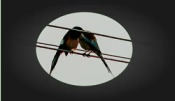Bird watching
Bird watching or birding lets you take a look in to the fascinating world of birds. It feels great when you spot a rare endangered bird. For beginners, it is interesting to observe birds, their features, social behaviour and aerodynamic skills. Bird watching helps kids and students learn about the ecosystem, food chains and migration patterns. This guide gives you an introduction and helps you start bird watching right away.

Birds see the world in UV and visible light. It means they see far more colours and shades than we do. Birds are experts at aeronatuics. An eagle flying high can make smooth turns by moving the tip of its wings, barely noticable to the human eye. Some birds like parrots can imitate sounds. Becoming a bird watcher is the start of an interesting journey of such discoveries.
There are two types of bird watchers ‐ bird watchers and birders.
Many people start as bird watchers and go on to become passionate birders. Let us look at the difference between bird watching and birding.
Bird watching
Bird watchers watch birds as a hobby. They focus on local birds in their neighbourhood. They identify birds, look for their nests, observe what these birds eat, and their migrating patterns.
Bird watchers may have bird feeders and bird baths in their property. They look at birds as their winged neighbors. They are interested in protecting local habitats favoured by birds.
Birding
Birders are more serious about birds. They are called Twitchers. They travel long distances to watering holes, looking for different species of birds. They buy accessories and gears to help spot elusive birds. They travel for days, looking for rare birds. They spend nights camping out in forests in search of birds.
International databases keep a count of birds spotted around the globe. This data helps identify vulnerable bird species and their distribution. Birders actively contribute to databases by joining bird counting activities or using mobile apps for recording their bird spottings.
Getting started with bird watching
Start by watching local birds. Birds forage or hunt for food during early mornings and evenings. They like safe places with perches. Hanging out a bird feeder is a good idea to attract birds. Shallow bird baths also work. Small birds do not prefer deep bird baths. Choose the depth of your bird bath based on the size of birds in your location.
Make sure you stay hidden. Birds like still places, without humans or pets. A tree or fence near by is an additional attraction as it gives birds a safe perch in case of attacking animals.

Bird watching without binoculars
You do not need binoculars or field glasses for bird watching. When you reach the stage where you hear they cry of a bird but cannot spot it, binoculars come in handy. Experienced bird watchers use binoculars for close up views of birds. Good bird watching glasses offer stunning close up views of birds.
Bird watching resources
Wikipedia has separate pages listing birds by location. You can listen to bird sound recordings online for identification. Social media is a good place to follow bird photographers and ornithologists.
Books and field guides help you get started with identifying birds by appearance. An international best seller book with stunning photos may not list birds in your country. So, choose books that focus on your country or region.
Happy birding !
